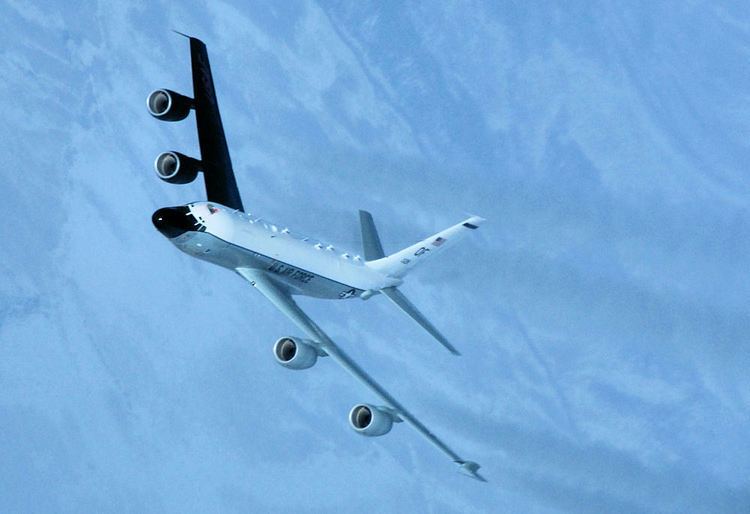 | ||
Active 1948-1949; 1950-present Part of Air Combat CommandTwenty-Fifth Air Force | ||
The 55th Wing is a United States Air Force unit assigned to Air Combat Command. The wing is primarily stationed at Offutt Air Force Base, Nebraska, but maintains one of its groups and associated squadrons at Davis-Monthan Air Force Base, Arizona as a geographically separated unit.
Contents
- Units
- Flying units and assigned aircraft
- History
- Cold War
- Current operations
- Lineage
- Components
- Stations
- References
The 55 WG is the only Air Force wing with continuous operations, maintenance, and aircraft presence in the United States Central Command area of responsibility since Operation Desert Storm.
The wing's mission is to provide worldwide reconnaissance, real-time intelligence, command and control, information warfare and combat support to U.S. leaders and commanders. One of the wing's units, the 55th Operations Group, operates 46 aircraft, including 13 models of seven different types. It is the largest wing in Air Combat Command and flies the most diverse number of aircraft.
Units
Flying units and assigned aircraft
38th Reconnaissance Squadron, RC-135
45th Reconnaissance Squadron, OC-135, RC-135, TC-135, WC-135
82d Reconnaissance Squadron (Kadena Air Base, Japan) - RC-135
95th Reconnaissance Squadron (RAF Mildenhall, UK), RC-135
338th Combat Training Squadron - aircrew training
343d Reconnaissance Squadron, RC-135
41st Electronic Combat Squadron, EC-130H
43d Electronic Combat Squadron, EC-130H
History
For additional history and lineage, see 55th Operations GroupThe "Fightin’ Fifty-Fifth" has made significant contributions to the defense of the United States of America for more than 50 years. Since its inception, the unit has operated around the world, flying a wide variety of aircraft.
Cold War
On 1 November 1950, the 55th Strategic Reconnaissance Wing (55 SRW) was activated under the Wing Base Organization at Ramey Air Force Base, Puerto Rico as the headquarters for the 55th Strategic Reconnaissance Group and its supporting units. From 1950 to 1954 the Wing's task was to perform strategic reconnaissance, charting photography, precise electronic geodetic mapping, and electronic reconnaissance missions. In 1952, the wing moved to Forbes Air Force Base, Kansas and converted to Boeing RB-50 Superfortresses. On 13 March 1953, a wing RB-50 flying out of Eielson Air Force Base, Alaska was attacked by Soviet Mikoyan-Gurevich MiG-15 fighters near Siberia, but was able to ward off the fighter's attack with defensive fire. The United States protested the attack, stating the plane was on a weather reconnaissance flight over international waters, 25 miles from the Kamchatka Peninsula. The Soviets responded by saying the plane was intercepted over their territory near Cape Krestovoi. A little more than three months later, on 29 July 1953 an RB-50 of the wing's 343d Strategic Reconnaissance Squadron was shot down by Soviet fighters about ninety miles south of Vladivostok. The Soviet Union did not deny the plane's location was over water, but claimed that the bomber had twice flown over Soviet territory and fired on their MiGs, who then returned fire defensively.
The wing formally assumed a global strategic reconnaissance mission in 1954 and transitioned to the RB-47E "Stratojet." The Wing was deployed at Ben Guerir Air Base, in what was then French Morocco, between May and August 1955.
When the mapping and charting functions originally assigned to the 55th Reconnaissance Group were transferred on 1 May 1954, the wing assumed the mission of global strategic reconnaissance, including electronic reconnaissance. It also carried out weather reconnaissance operations until June 1963, and photographic reconnaissance missions until May 1964.
The 55 SRW moved to Offutt Air Force Base, Nebraska, in August 1966. That same year the 55th’s 38th Strategic Reconnaissance Squadron assumed responsibility for SAC’s airborne command and control system. The 2d Airborne Command and Control Squadron inherited this mission after activation in April 1970. The 1st Airborne Command and Control Squadron, flying E-4A aircraft, transferred to the 55th on 1 November 1975, bringing with it the National Emergency Airborne Command Post, now called the National Airborne Operations Center. The Wing flew reconnaissance operations during the U.S. military operations in Grenada in 1983 and Libya in 1986. On 1 March 1986, the 55 SRW became the host unit at Offutt after the inactivation of the 3902d Air Base Wing.
The Wing ended nearly twenty-five years of continuous Airborne Command Post ('Looking Glass') operations in 1990, assumed a modified alert posture, and continued worldwide reconnaissance. In October 1998, the wing transferred control of the EC-135 LOOKING GLASS mission to the United States Navy's TACAMO aircraft and the 7th Airborne Command and Control Squadron, which flew the EC-135 LOOKING GLASS aircraft, inactivated.
The wing deployed a Rivet Joint RC-135 from Hellenikon Air Base, Greece to Riyadh Air Base, Saudi Arabia on 8 August 1990, and began 24-hour-a-day reconnaissance of the region two daus later for Central Command Commander Gen. Norman Schwarzkopf, under Operation Desert Shield. At the start of Operation Desert Storm, 18 January 1991, the wing continued to provide real-time information. In 1996, this operation moved to Prince Sultan Air Base, Saudi Arabia. On 9 August 2015, the wing celebrated 25 years of what is believed to be the longest continuous deployment by an Air Force unit.
Current operations
The 55th Strategic Reconnaissance Wing became the 55th Wing on 1 September 1991, to reflect the wing’s performance of a diversity of missions. When SAC disestablished and Air Combat Command (ACC) established, the wing transferred to ACC and gained its fifth operational location.
The 55th SRW and the 55th Wing has been awarded the USAF's P. T. Cullen Award five times since 1971 for its contributions to photo and signal intelligence collection.
Lineage
Components
Groups
Squadrons
